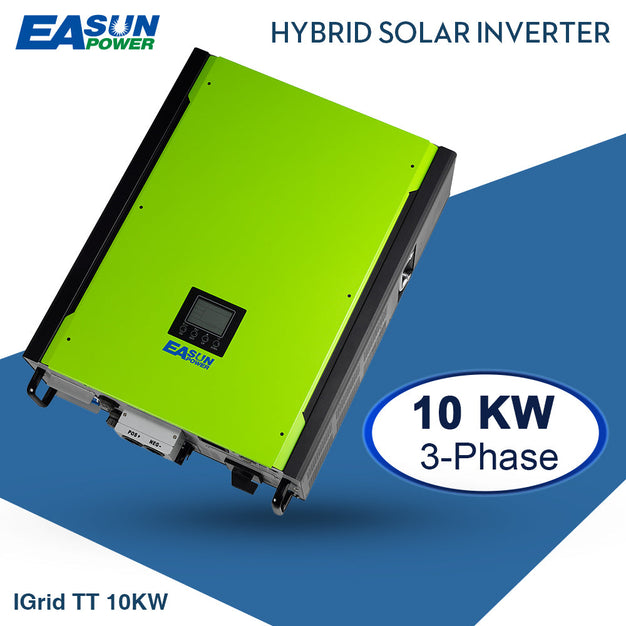Unlock the Power of the Sun: Discover the Ultimate Solar Inverters for Seamless Energy Integration!
As the world increasingly shifts towards sustainable energy solutions, solar inverters have become a vital component in harnessing the power of the sun. These devices play a crucial role in converting the direct current (DC) generated by solar panels into alternating current (AC) electricity, which is used to power our homes and businesses. Selecting the right solar inverter is essential for optimizing energy efficiency and ensuring that your renewable energy system operates at its peak potential. With the growing popularity of solar energy and other renewable sources, understanding how to effectively manage and integrate these systems has never been more important. Whether you're a homeowner looking to reduce your carbon footprint or a business aiming to lower energy costs, the right solar inverter can make a significant difference in your energy management strategy.

Understanding Solar Inverters
Solar inverters are devices that convert the electricity generated by solar panels into a usable form for your home or business. There are several types of solar inverters available on the market, each with its unique features and benefits. The most common types include string inverters, microinverters, and power optimizers. String inverters are the most widely used and connect a series of solar panels together, making them cost-effective but potentially less efficient if one panel is shaded. Microinverters, on the other hand, are installed on each solar panel, allowing for independent operation and maximizing efficiency, especially in shaded areas. Power optimizers work alongside string inverters to enhance the performance of individual panels without the higher costs of microinverters. Each type has its advantages and disadvantages, making it essential to consider your specific energy needs and installation environment when choosing the right inverter.
Key Features of Solar Inverters for Energy Integration
When selecting a solar inverter that facilitates the integration of renewable energy sources, there are several key features to consider. First, grid-tied capabilities are essential for systems that will connect to the electrical grid, allowing you to sell back excess energy. Additionally, energy storage solutions can be integrated to store surplus energy for use during peak hours or outages. Compatibility with various renewable technologies, such as wind or hydro energy systems, is also crucial for those looking to create a hybrid energy solution. Other important features to look for include monitoring capabilities, which allow you to track your energy production and usage in real-time, and smart technology integration, enabling seamless communication with your home energy management system. These features not only enhance efficiency but also provide more control over your energy consumption.
Comparative Analysis of Solar Inverters
Conducting a comparative analysis of different solar inverter technologies reveals significant differences in efficiency ratings, reliability, installation ease, and maintenance requirements. Efficiency ratings indicate how much of the generated energy is converted to usable electricity; higher ratings mean more energy savings. Reliability is crucial, as a dependable inverter reduces the risk of unexpected outages and costly repairs. Ease of installation can influence installation costs and time, with some inverters designed for quick setup. Maintenance requirements also vary, with microinverters typically needing less upkeep compared to string inverters, which may require periodic checks on the entire string of panels. Additionally, consider user experiences shared by friends and family; for instance, one of my friends recently shared how switching to a microinverter system helped them eliminate shading issues and significantly boost their energy production. These factors collectively influence the overall performance of renewable energy systems, making it essential to compare inverters based on your specific situation.
Considerations for Selecting the Right Solar Inverter
Choosing the right solar inverter involves evaluating several factors, including system size, energy needs, and future scalability. It's important to calculate your current and future energy consumption to select an inverter that can handle your requirements as they grow. Assessing the inverter's performance specifications, such as efficiency and power output, alongside warranty terms ensures you are making a long-term investment. A good warranty reflects the manufacturer's confidence in the product and provides peace of mind. Additionally, consider installation and maintenance costs, as these can vary significantly among different inverter types. Engaging with local solar energy experts or reading reviews from other users can provide valuable insights into which inverter will best meet your unique needs, ultimately leading to long-term satisfaction.
Final Thoughts on Choosing Solar Inverters
In conclusion, selecting the right solar inverter for integrating renewable energy sources is a critical decision that can significantly impact your energy efficiency and overall satisfaction with your renewable energy system. By understanding the different types of inverters, their essential features, and conducting a thorough comparative analysis, you can make an informed choice that aligns with your energy needs. Remember to consider factors such as scalability and warranty terms to ensure your investment pays off in the long run. Embracing solar energy solutions not only contributes to sustainability but can also lead to considerable cost savings on energy bills. As you embark on your journey towards renewable energy, take the time to research and evaluate your options carefully—your future self will thank you.



